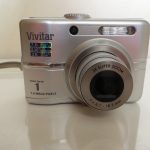We are an affiliate
YorkCameras is a participant in the Amazon Services LLC Associates Program, an affiliate advertising program designed to provide a means for sites to earn advertising fees by advertising and linking to Amazon.co.uk.“As an Amazon Associate, I earn from qualifying purchases.”
Choosing a Compact Digital Camera
If you’re looking for a good compact or “point and shoot” camera, there are a number of factors to take into consideration. Usually people buy compact digital cameras for their portability and ease of use, when they don’t really require that near-professional image quality that would be obtained using a larger and more expensive digital single-lens reflex camera. Let’s take a closer look at the different types of digital compact cameras and key performance features.
Styles
Digital cameras come in several categories, including ultracompact, compact, advanced compact or bridge cameras, and single-lens reflex (SLR) cameras. Ultracompact cameras are small enough to fit in a pocket or purse and are easily transportable, and the lenses retract when not in use. Compact cameras are slightly larger but can offer more features and larger control buttons. Advanced compact or bridge cameras are still larger and can include advanced features such as a larger image sensor, image stabilization, and HD video, but they are more expensive. SLR cameras are the largest, most sophisticated, and most expensive of the group. Here are some typical price ranges for digital cameras:
Ultracompact: up to about $200
Compact: up to about $250
Advanced compact or bridge cameras: up to about $450
SLR: from $400 up to several thousand dollars
Performance
There are several factors that determine a compact camera’s performance. This includes the size and the number of megapixels of the image sensor, the quality of the lenses, the amount of optical zoom, and the aperture size. Today’s compact cameras typically offer image sensors in the range of ten to fourteen megapixels. This is usually enough resolution most photographers. The number of megapixels is usually not the only factor in determining image quality. It is also important to consider the quality of the pixels. Does the photo have enough focus? Is there enough contrast in the image, and are the objects rendered sharply? A good way to get a sense of the overall image quality is to read online reviews, including those that test compact camera performance over a range of conditions.
Lenses
The lenses of compact digital cameras are an important aspect of performance that are sometimes overlooked. First there is the focal length of the lens. Many compact digital cameras have a range of focal lengths. Normal perspective is 50mm. Wide-angle lenses have focal-length less than 50mm – typically 35mm down to 24mm. Telephoto or zoom lenses have larger focal-lengths up to 100mm or more. Very good digital cameras have a range from 24mm wide-angle up to over 800mm telephoto. The f-number is a measure of the light-gathering power or “speed” of the lens- the lower the f-number the greater the light-gathering power. So if you are taking any photographs in low-light conditions, you will want to have a low at f-number such as f/2.8. Typically digital compact cameras will have a range of f numbers- low numbers for wide-angle mode to high numbers for telephoto mode. Optical zoom is an important factor when you are looking to take close up photos of objects from a distance.
Image Stabilization and smart auto modes
Other important factors influencing the performance of digital compact cameras include image stabilization and smart auto modes. Image stabilization corrects for unwanted camera shake, which is one of the leading causes of blurry photographs. This can help keep photographs crisp and sharp especially when using zoom. Many compact cameras also have smart auto mode to optimize camera settings to help you take the best picture – letting you focus on the best part of photography – framing your image.
Timing
Another important aspect of compact cameras is how fast you can turn on a compact camera and take the first picture, and then how long it takes to shoot the next picture after that. A compact digital camera with fast timing can help you capture that “can’t miss” surprise moment. Look for a model that can take the first picture within 2 seconds, and the next picture within less than a second.
Image format
Most ultracompact and compact cameras take images in jpeg format, which is convenient for uploading to the web and sharing your photos with friends and family. Most advanced compact cameras also have the option to store images in RAW format, which gives you the ability to highlight details and bring out shadow areas in your photos using image editing software.
Batteries
Batteries are an important consideration when looking for a compact camera. Some compact cameras use AA batteries, while others use lithium ion cells. AA batteries are convenient because you can purchase them in just about any store in the world. Lithium ion cells are rechargeable and tend to last a long time between charges, although this depends on the power consumption of the particular camera. Regardless of battery type be sure to take along extra batteries whenever you’re on the go to make sure you never run out of juice.
Summary
When shopping for a compact digital camera, make sure to consider the size and portability of the camera. Choose a camera that fits your budget and price range. Review the performance features including the image sensor pixel quality, the lens focal-length and f-number, and the image stabilization and auto-mode capabilities. Consider the camera timing and image formats. Finally, read some online reviews to see what other people who bought the camera are saying. Taking these steps will help to ensure that you get the right camera for your needs.



